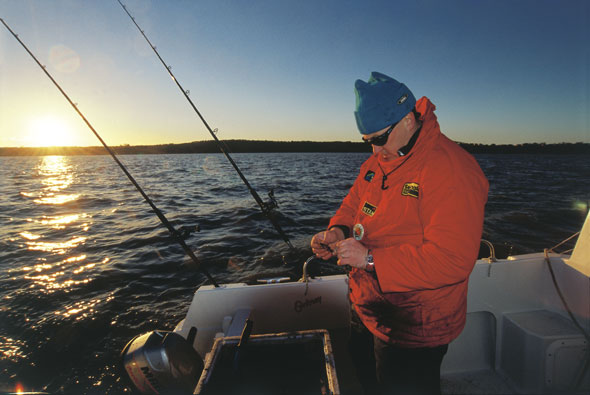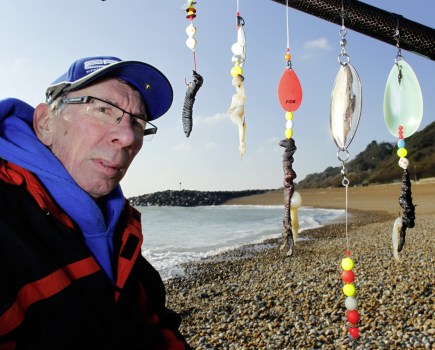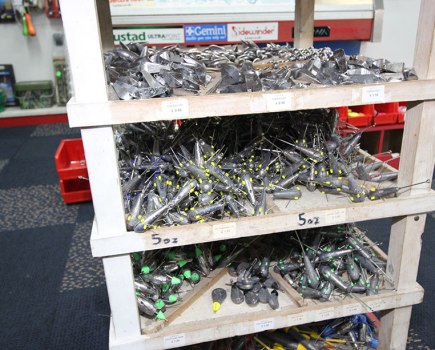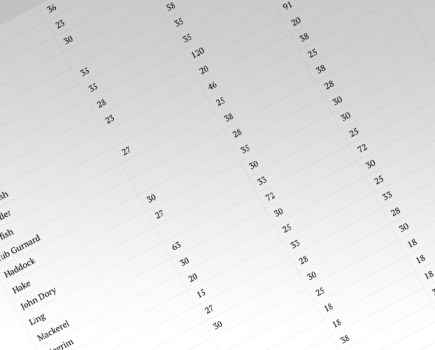To fish effectively with boatcasting tackle you have to be aware of the uptiding rules, which are based on water depth and speed of the tide. Expert uptider, Dave Lewis explains the principles
UPTIDING is easy, isn’t it? You tie a spiked lead to the end of the line, attach a trace and sling it in the water. You could try it, but I doubt you will catch much because this method is more complicated than that.
You have forgotten to take into account the strength of the tide, which will change throughout the day, the depth of water, and the type of sea bed you are fishing. Forget these factors and you are going to have a very dull day’s fishing.
Before you launch a lead you have to understand casting distances and angles. An angler fishing on a private boat with just a few rods on the deck will have far more space to fish than a member of a party on a charter boat.
Conditions determine the casting angle and distance, but if you are fishing aboard a crowded boat you are forced to cast where there is space, rather than the ideal place. The solution is to avoid full boats, but when this is impossible there are a few tricks that may boost your chances.
As a rule, the stronger the tide and the greater the depth of water, the tighter to the anchor warp and the further from the boat you have to cast, remembering you can uptide in up to about 100ft of water, though in any appreciable run of tide 70ft is probably the maximum.
Faced with a combination of depth and tide, the only option is to cast uptide, which gives time for the wired sinker to hit bottom and dig in fairly close to the boat. This might sound as if you are defeating the objective of casting outside of the scare area, which is minimised as depth and flow increase. Casting tight to the anchor rope means the tide will create a bow of line that forms in a near vertical plane, which is more efficient at holding bottom than a horizontal bow, which happens when you cast across the tide.
In this situation the tide is far more likely to prematurely trip the lead because of water pressure pushing on a great combined line surface area. You want the line to cut through the tide, not act like a giant anchor.

Fishing aboard a busy charter boat means you rarely have the luxury of being able to cast where tide conditions dictate and you run the risk of getting crossed lines if you release a large bow of line with so many other lines down in the water.
Under these circumstances I have found it best to increase the lead size to 8oz or even 10oz. Heavier leads hit the bottom quicker, and given their obvious holding power need a much smaller bow of line to hold them firmly on the sea bed.
I uptide in the Bristol Channel, which experiences very strong tides, yet I never use more than 6oz to hold bottom, because I can cast where I want and release as much line as necessary to hold.
When fishing in strong tides it is best to use a fixed grip lead, rather than a breakout because weights with swinging wires often break free prematurely and drag, then getting snagged or tangled in another line or swinging in mid-water.
As the run of tide starts to decrease towards either high or low water slack, you can progressively increase the angle you cast in relation to the anchor warp, so that at slack tide you are casting roughly 90 degrees to the anchor warp.
Then as the next tide starts to gather strength, you can progressively reduce the angle you cast. If you are fishing aboard a full charter boat then limited space dictates that some anglers must fish the stern positions, where they will not be able to effectively cast uptide. In this case they have the option of either downtiding or sticking with uptiding, casting across the tide and allowing a very large loop of line to form to ensure the lead grips. One advantage of the position is that nobody is going to cast across your line.
NO TIME FOR IDLE HANDS
With a bait out and anchored on the sea bed there’s not much else you can do… apart from baiting up a second or even a third hook length!
For the most part uptiding is a selfhooking or snaring technique and this is why it is so successful, but I often see many anglers failing to catch any fish because they fail to correctly ‘set’ the hook.
Note, I said ‘set-the-hook’, I did not say strike. You do not strike when uptiding. Think about it, you have a huge bow of slack line between the rod tip and the terminal rig, which in effect is a huge elastic band or spring.
Regardless of how hard you try and strike in the accepted way, you are not going to move the hook an inch, let alone set it firmly into a fish’s mouth.
Uptide bites come in two forms; delicate nodding rod tips, or classic uptide break-outs when the fish pulls the spiked lead out of the sea bed and the tensioned rod tip flicks back parallel. In either cases do not strike.
If your rod tip is nodding, pick up the rod and swiftly retrieve the bow of slack line. If the lead still has not broken out you will feel the pressure on the rod steadily increase and here many inexperienced anglers wrongly believe that this is due to the weight of the fish.
Keep winding, and eventually the pressure will break the lead free. At this stage it is all too easy to think you have now lost a fish, and often I see anglers stop winding and starting to curse their luck.
The correct procedure is to continue winding and if the fish still has the bait in its mouth, which is likely, you will feel the weight of the fish come onto the rod: keep winding!
Wind until the line gets really tight, all the time trying to establish a straight line of contact between the rod tip and the fish. Only when this has been achieved should you allow the rod tip to be wound down and then firmly set the hook by smoothly lifting the rod to the vertical, and then keeping it there. Now you should feel the satisfying weight of the fish thumping on the rod tip.
If the fish has broken the lead out immediately establish a straight line of contact between rod tip and fish.
Wind furiously until you feel the weight of the fish, which now may be well downtide of the boat, then wind the rod tip down and firmly lift into the fish to set the hook.
With the fish firmly hooked and banging away on your rod tip, you can relax and enjoy the fight. Forget any thoughts of aggressively pumping the fish towards the surface, the correct way to beat a fish on an uptider is to keep the rod tip as close to the vertical as possible allowing the rod action, reel clutch and elasticity of the line to absorb any powerful runs of the fish.
Slowly, steadily, wind your fish towards the boat, trying to keep even pressure on the fish at all times. Too much or lack of pressure can result in the hook getting ripped out of lightly hooked fish, bending the hook out of big fish or poorly tied knots snapping.
 Always carry a few heavy-duty elastic bands, which can be used to adapt a breakout into a fixed lead. All you do is tightly wrap the bands around the swinging wires to lock them in place.
Always carry a few heavy-duty elastic bands, which can be used to adapt a breakout into a fixed lead. All you do is tightly wrap the bands around the swinging wires to lock them in place.







